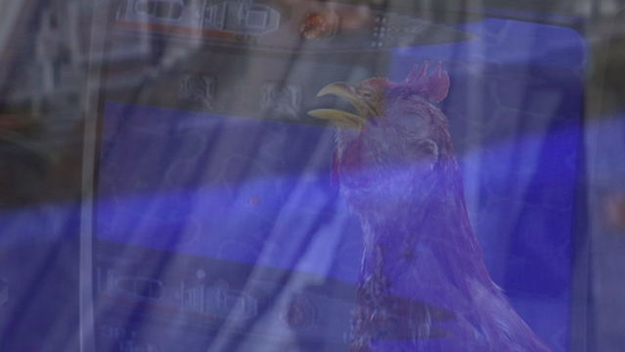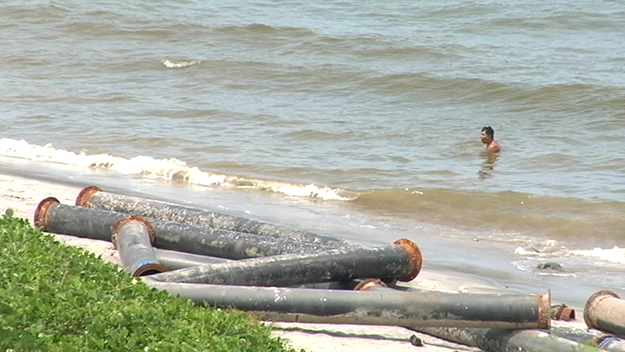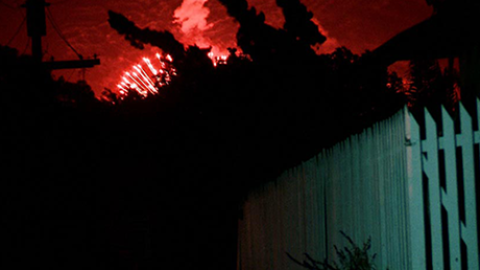An Epic of Understanding: John Gianvito’s Wake (Subic)

Consider the lengths of time between Jean Vigo’s death and the first appearances of Zéro de conduite and L’Atalante in the U.S. (13 years), or between the first screening of Jacques Rivette’s Out 1 and its recent appearances on Blu-Ray (45 years), and it becomes obvious that the popular custom of listing the best films of any given year is unavoidably a mythological undertaking. By the same token, film history in the present should be divided between important filmmakers skilled and successful in hawking their own goods, from Alfred Hitchcock to Spike Lee to Lars von Trier, and those who, for one reason or another, aren’t—a less definitive roll call that includes, among many others, Charles Burnett, Ebrahim Golestan, Luc Moullet, Peter Thompson, Orson Welles, and John Gianvito.
I haven’t seen Gianvito’s early shorts, one of which is called What Nobody Saw (90), but its very title seems emblematic of his career—as does the epigraph from Cesare Pavese opening the first part of his first feature, The Mad Songs of Fernanda Hussein (01), which introduced me to his work and remains my favorite: “Everywhere there is a pool of blood that we step into without knowing it.” His second and best-known feature, Profit Motive and the Whispering Wind (07), testifies to the same conviction, and his nine-hour documentary diptych, For Example, The Philippines, which he has working on for the past decade, is a epic demonstration of the wisdom of Pavese’s remark; Vapor Trail (Clark) (10; 264 minutes) and now Wake (Subic) (277 minutes) concentrate on the human ravages left by the Clark Air Base and Subic Bay naval base—for almost a century, the two largest U.S. military compounds outside North America—after the Philippine Senate voted to eject them in 1991. Departing without any environmental cleanups or any sense of responsibility about what remained, the U.S. left behind numerous toxic materials in the drinking water and elsewhere that tens of thousands of Filipino citizens knew nothing about, resulting in a massive health blight on successive generations that in many ways recalls the lead deposits in the drinking water of Flint, Michigan that have only recently been publicly acknowledged, with comparably catastrophic results.
The differences between Flint and two former military bases in the Philippines should be stressed—the diversity of toxic materials left behind in the latter (not to mention the alarming array of consequences, which include, to quote Gianvito, “premature births, deformed babies, miscarriages, skin allergies, heart problems, nervous system disorders, leukemia and cancers, problems that persist to this day”), and the (very belated) attempts to rectify part of the damage in the former—but the institutional indifference compounded by capitalist greed and apparent racial entitlement in both cases are strikingly similar. In Gianvito’s diptych, however, the buried scandal is viewed as only one part of a much larger picture, and Wake—which premiered at the Viennale last fall, and screens this week in Rotterdam—makes this broader canvas even more prominent than its predecessor.

Being a film poet and a historian (as well as a film historian, who worked for years at the Harvard Film Archive), not to mention an investigative reporter, Gianvito isn’t content merely to expose an ongoing national disaster. He also meditates on the events as part of an even bigger issue, encompassing the no-less-neglected history of the Philippine-American War between 1899 and 1913, and, more implicitly, the environmental problems created by U.S. bases in Greenland, Iceland, Italy, Japan, Panama, Spain, and the U.K. (This scope accounts for the overarching title of Gianvito’s project, For Example, The Philippines.) The ultimate focus of both Vapor Trail (Clark) and Wake (Subic), like that of The Mad Songs of Fernanda Hussein and Gianvito’s contributions to the omnibus feature Far from Afghanistan, is the legacy of U.S. military involvement and all that it entails.
Past and present are juxtaposed throughout Wake, with a musical precision in the editing and sound-mixing that makes intertitles (accounts of the Philippine-American War and bits of political speeches), still photographs and other archival materials (including silent newsreel footage and a 1908 recording of a William Howard Taft speech), Carolyn Forché’s occasional voiceover narration, and actual music (some of which is furnished by Filipino filmmaker Lav Diaz) every bit as powerful, as pertinent, and as present as the contemporary footage. And the contemporary footage is not simply talking-head interviews and place-setting master shots but sustained encounters with particular people whom we get to know over the course of the film and lyrical interludes involving everyday life and landscapes. One of the most startling cuts, 88 minutes into Wake, takes us from an archival black-and-white photograph of a city street in the 1920s or ’30s to a moving color shot of what could be the same street today as the camera follows a car bearing a coffin. (Funerals and cemeteries in Gianvito’s diptych are as important as they are in Profit Motive and the Whispering Wind.)
The facts presented about both past and present are devastating and often shocking, but Gianvito’s scruples as a historian and commentator guarantee a vision that moves beyond simple didacticism. As I noted in FILM COMMENT when Vapor Trail showed at the Viennale in 2012, it’s characteristic of Gianvito “that whenever he encounters Filipino interview subjects who don’t share his disgust with American negligence and indifference, even after losing many family members as a consequence, he doesn’t hesitate to include their contrary responses in his film.” Even the excruciating irony of his showing one of the deformed children—a contorted mute who has to use his feet to grasp objects—playing a war video-game with his toes isn’t exploited as an isolated detail; it’s shortly followed by a radical activist, Teofilo “Boojie” Juatco, expounding on how “colonial thinking” remains in the very “bones” of Filipinos today.

Indeed, Gianvito’s handling of Juatco throughout creates an indelible portrait that is beautifully constructed, moving from his lengthy and moving account of his own life and career delivered directly to Gianvito’s camera (complete with measured breaks and pauses) to his aforementioned thoughts about “colonial thinking” while driving a car, then to an extended sequence of him patiently and persistently coaxing a group of locals to organize themselves politically, next to a prolonged conversation with other people on the street about what’s remembered (or, more often, forgotten) about the Philippine-American War, and finally to a moving performance of a song with his own guitar accompaniment behind the final credits.
More generally, Gianvito is as attentive to activists tirelessly working for the Alliance for Bases Clean-Up (his major collaborators) as he is to the families of stricken children and former base workers, many of whom contracted their health problems long before the bases were abandoned. An ethical purist who respects his audience as much as the people he films, Gianvito has this time outfitted his lengthy essay with a 10-minute intermission. As in his extended interview with Juatco, he privileges our capacity to think and meditate as well as feel.
Wake (Subic) screens February 3, 4, and 5 at the International Film Festival Rotterdam, and has its North American premiere on February 27 in Doc Fortnight at the Museum of Modern Art.
Jonathan Rosenbaum has been publishing film criticism for 40 years. A significant amount can be found at JonathanRosenbaum.net.





